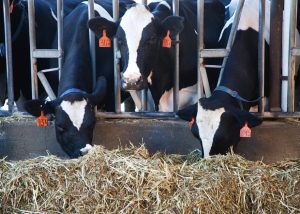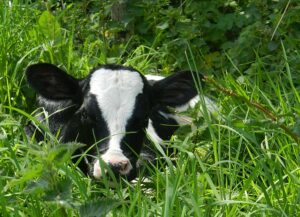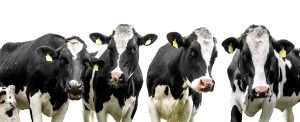Álvaro García
Genomic testing has become a powerful tool for dairy producers to make smarter decisions early in a calf’s life. With just a hair or tissue sample, a genomic report can predict how a heifer will perform in milk production, fertility, health, and even feed efficiency. This article walks through a sample genomic evaluation and explains what each number means. These predictions are based on tens of thousands of DNA markers compared to reference populations with known performance. By identifying animals with superior genetics early on, producers can optimize culling, breeding, and investment decisions before the calf ever enters the milking herd.
General information
At the top of the report, you would see the calf’s identification, breed (Holstein, in this case), and birthdate, which were omitted from this example. Also listed would be the evaluation date when the genomic test was processed and the results calculated.
Genomic report for heifer calf
Trait |
Genomic value |
percentile rank |
Reliability |
Net Merit $ (NM$) |
+305 |
69 |
69% |
Dairy Wellness Profit Index (DWP$) |
+466 |
83 |
70% |
Production Index (PT) |
+2921 |
92 |
73% |
Fat |
+58 |
97 |
74% |
Protein |
+43 |
94 |
73% |
Somatic Cell Score (SCS) |
-2.77 |
96 |
71% |
DPR |
+2.0 |
95 |
68% |
Livability |
+0.2 |
61 |
66% |
Lifespan |
+4.4 |
90 |
71% |
CW$ |
+127 |
79 |
71% |
Wellness Trait Index (WT$) |
+75 |
81 |
68% |
Breeding Attribute Index (BA$) |
+61 |
95 |
66% |
General overview
Each genomic report provides three types of data for every trait:
- Genomic Value – the predicted genetic merit of the calf for a trait
- Percentile Rank – how the calf compares to other tested animals (higher is better)
- Reliability (%) – confidence in the prediction, based on genomic data.
Economic indexes
These combine multiple traits into a single figure that reflects the calf’s potential lifetime profitability.
- Net Merit (NM$): +305 (69th percentile) ⮕ This index predicts the added lifetime value of the animal compared to the breed average. A value of +305 means this heifer is expected to generate $305 more than the average cow, mostly through improved production, health, and fertility.
- Dairy Wellness Profit Index (DWP$): +466 (83rd percentile) ⮕ This index emphasizes health and longevity, reflecting how much more profit the animal may generate due to resistance to disease and improved wellness traits.
- CW$ (Calf Wellness): +127 (79th percentile) ⮕ A higher CW$ means greater genetic resistance to early-life diseases such as pneumonia, scours, and umbilical infections, which can reduce mortality.
Production traits
These traits measure milk component output and overall productivity.
- Production Index (PT): +2921 (92nd percentile) ⮕ A high score here reflects outstanding potential for total milk solids production, factoring in both volume and component yield.
- Fat: +58 (97th percentile) ⮕ This indicates a strong capacity for butterfat production, which is particularly valuable in component-based milk pricing systems.
- Protein: +43 (94th percentile) ⮕ Also a key milk component, this result shows excellent potential for protein yield, which improves milk processing value.
Health and fertility traits
These traits predict the animal’s ability to stay healthy and reproduce efficiently.
- Somatic Cell Score (SCS): –2.77 (96th percentile) ⮕ Lower values are better. This extremely low score suggests an extremely low genetic risk for mastitis, leading to better udder health and milk quality.
- Daughter Pregnancy Rate (DPR): +2.0 (95th percentile) ⮕ A higher DPR indicates that daughters of this animal will have improved fertility. It also suggests this heifer may cycle and breed more easily.
- Livability: +0.2 (61st percentile) ⮕ This reflects the genetic likelihood that the animal will remain alive and productive in the herd. While modest, this is still above average.
- Lifespan: +4.4 (90th percentile) ⮕ This high score means the animal is expected to remain productive in the herd well above the breed average.
Wellness and breeding indexes
These values summarize broader indicators of animal health and suitability for breeding.
- Wellness Trait Index (WT$): +75 (81st percentile) ⮕ This index reflects genetic resistance to costly cow health conditions, such as metritis, lameness, and displaced abomasum.
- Breeding Attribute Index (BA$): +61 (95th percentile) ⮕ A high BA$ indicates the calf is a strong genetic candidate for breeding programs, especially embryo transfer or donor selection.
Reliability scores
Most of the traits show reliability levels between 66% and 74%, which is typical for young animals evaluated through genomics. While not perfect, these predictions are more accurate than traditional pedigree-based evaluations and improve decision-making in young stock.
What all this means
This heifer stands out in multiple areas:
- Top 10% for production traits (fat, protein, PT)
- Remarkably high disease resistance (SCS, WT$, DWP$)
- Strong reproductive potential (DPR, lifespan, BA$)
Together, these make her a strong candidate for breeding and milk production, as noted in the summary of her report. She would be well suited for keeping as a replacement, entering a breeding program, or even selling as a high-value genetic investment.
Practical applications for producers
- Culling Decisions: Do not raise every heifer; prioritize those with strong NM$, fertility, and health scores.
- Breeding Strategy: Use high-BA$ heifers for embryo programs or flushes, and match with sires to improve any weaker traits.
- Health Management: Calves with low CW$ may need more preventive care; this one does not.
- Marketing: High DWP$ and PT values can increase the sale value of this animal to other herds.
The full list of references used in this article is available upon request.
© 2025 Dellait Knowledge Center. All Rights Reserved.









